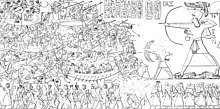User:Tmitfc/Twentieth Dynasty of Egypt
| This is the sandbox page where you will draft your initial Wikipedia contribution.
If you're starting a new article, you can develop it here until it's ready to go live. If you're working on improvements to an existing article, copy only one section at a time of the article to this sandbox to work on, and be sure to use an edit summary linking to the article you copied from. Do not copy over the entire article. You can find additional instructions here. Remember to save your work regularly using the "Publish page" button. (It just means 'save'; it will still be in the sandbox.) You can add bold formatting to your additions to differentiate them from existing content. |
Article Draft[edit]
Lead[edit]
The Twentieth Dynasty of Egypt (notated Dynasty XX, alternatively 20th Dynasty or Dynasty 20) is the third and last dynasty of the Ancient Egyptian New Kingdom period, lasting from 1189 BC to 1077 BC. The 19th and 20th Dynasties furthermore together constitute an era known as the Ramesside period. During the period of the Twentieth Dynasty, Ancient Egypt facing the crisis from the invading of See Peoples, but have successfully defend Egypt, while still been heavy damage.
Article body[edit]
After the death of the last pharaoh of the 19th Dynasty, Egypt had enter into a civil war period. And because of the many lost of record, we did not know that what happen at the time when in the end of the 19th Dynasty which cost the civil war. And in the end, Setnakhte end the civil war, and become the new ruler of Egypt, formed 20th Dynasty of Egypt.
From the reign of Setnakhte and his son Ramesses III, Egypt facing the crisis that cost by the invading of See Peoples, which is also one of the main reason cost Late Bronze Age collapse. The Sea People costed a large amount of damage to the people of Egypt that left clear record:
"All at once the lands were removed and scattered in the fray. No land could resist their arms, from Hatti, Kode, Carchemish, Arzawa, and Alashiya on – being cut off at one time. A camp was set up in Amurru. They desolated its people and its land was like that which had never existed. They were coming forward toward Egypt, while the flame was prepared for them.”——Foreboding inscription from the second pylon of Medinet Habu, a Temple devoted to the life of Ramses III of Egypt。[1][edit]
For the Outside of Egypt, it cost more devastating results, such as the long counterpart of Egypt, the Hittites, were never able to restore their state again.
With the victory in the Battle of Djahy and the Battle of the Delta during Year 8 of Ramesses III's reign, Egypt successfully repeal the invading forces of Sea Peoples, which protect Egypt from the ruin like other Bronze Age civilization. During the Twentieth Dynasty, many of the temples had build up to showing the power of Egypt, but it also make the religion group holding more power that the pharaoh.[2]
But with facing the situation of heavy climate change, the infighting of the loyal family, and the growing power of the local religion group and noble, cost the decline of the the Twentieth Dynasty. After the chaos by the death of Ramesses XI, the Last pharaoh of Twentieth Dynasty, Smendes, a noble of the Egypt, became the first Pharaoh of 21th Dynasty, mark the end of 20th Dynasty.
Sea Peoples in Egypt[edit]
The late 13th century BC was a time of uncertainty and conflict for peoples and polities of the Aegean and Eastern Mediterranean due to the invade by Sea Peoples, which cost Late Bronze Age collapse.[3] While there were not much information left to show us why the Sea Peoples began the large scale invade, from the writing evidences, that showing the weakening of central administrations, erosion of political powers, and food shortage might be the reasons. [4]
From Ramses III's mortuary temple at Medinet Habou depicting a chaotic scene of boats and warriors entwined in battle in the Nile delta, it showing that Sea Peoples were seaborne foes from different origins.[5] They launched a combined land-sea invasion that destabilized the already weakened power base of empires and kingdoms of the old world, and attempted to enter or control the Egyptian territory.
While with the victory in the Battle of Djahy and the Battle of the Delta during Year 8 of Ramesses III's reign, Egypt successfully repeal the invading forces of Sea Peoples, the damage that cost the collapse of Eastern Mediterranean world largely damage the trade route of Egypt, due to most of their trading partner had been destroy by Sea Peoples.

References[edit]
- Grandet, Pierre (2014-10-30). "Early–mid 20th dynasty"
- ^ "The Mystery of the Sea Peoples | Classical Wisdom Weekly". classicalwisdom.com. Retrieved 2024-03-18.
- ^ "Early–mid 20th dynasty". escholarship.org. Retrieved 2024-03-01.
- ^ Ward WA, Sharp Joukowsky M. (1992). The Crisis years: the 12th century BC: from beyond the Danube to the Tigris.
- ^ Kaniewski D. (2010). Late Second-Early First Millennium BC abrupt climate changes in coastal Syria and their possible significance for the history of the Eastern Mediterranean.
- ^ Roberts RG. Identity, choice, and the Year 8 reliefs of Ramesses III at Medinet Habou.
